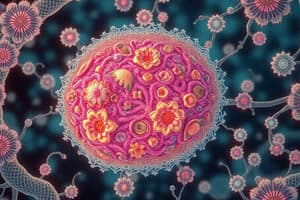Podcast
Questions and Answers
Which process specifically describes the passive transport of water molecules across a selectively permeable membrane?
Which process specifically describes the passive transport of water molecules across a selectively permeable membrane?
- Active Transport
- Facilitated Diffusion
- Diffusion
- Osmosis (correct)
Which protein type utilizes energy to transport solutes against their concentration gradient?
Which protein type utilizes energy to transport solutes against their concentration gradient?
- Aquaporins
- Channels
- Carrier Proteins
- Protein Pumps (correct)
In which phase of the cell cycle do chromosomes replicate?
In which phase of the cell cycle do chromosomes replicate?
- G2 phase
- M phase
- G1 phase
- S phase (correct)
What term describes the form of DNA associated with proteins that occurs within the nucleus?
What term describes the form of DNA associated with proteins that occurs within the nucleus?
Which stage of the cell cycle is directly responsible for preparing the cell for division?
Which stage of the cell cycle is directly responsible for preparing the cell for division?
During which mitotic stage do the chromosomes line up along the metaphase plate?
During which mitotic stage do the chromosomes line up along the metaphase plate?
What is the term for the structures on sister chromatids that attach to spindle fibers during mitosis?
What is the term for the structures on sister chromatids that attach to spindle fibers during mitosis?
Which phase of meiosis is characterized by the exchange of genetic material between homologous chromosomes?
Which phase of meiosis is characterized by the exchange of genetic material between homologous chromosomes?
What part of the nucleus acts as gates that control substances entering or exiting it?
What part of the nucleus acts as gates that control substances entering or exiting it?
Which organelle performs protein synthesis in eukaryotic cells?
Which organelle performs protein synthesis in eukaryotic cells?
Which organelle is specifically involved in breaking down fatty acids?
Which organelle is specifically involved in breaking down fatty acids?
What type of fiber that makes up the cytoskeleton is composed of tubulins?
What type of fiber that makes up the cytoskeleton is composed of tubulins?
What is the process where animal cells shrivel due to an imbalance in solute concentrations called?
What is the process where animal cells shrivel due to an imbalance in solute concentrations called?
Which structure is known as a 'communicating junction' in cells?
Which structure is known as a 'communicating junction' in cells?
Which of the following cell types is characterized by the absence of a nucleus?
Which of the following cell types is characterized by the absence of a nucleus?
What type of active transport involves the engulfing of small fluid particles by the cell?
What type of active transport involves the engulfing of small fluid particles by the cell?
Flashcards are hidden until you start studying
Study Notes
Cell Biology
- All cells share a plasma membrane, cytosol, and ribosomes.
- Microscopes are used to view cells.
- The nuclear membrane controls substances entering and exiting the nucleus.
- Rough ER is responsible for protein synthesis in eukaryotic cells.
- Peroxisomes break down fatty acids.
- Prokaryotic and eukaryotic cells are both considered cell types.
- Chloroplasts are found in plant cells, but not animal cells.
- The plasma membrane does not manufacture, distribute, or break down molecules.
- Flagella are primarily used for locomotion in prokaryotic cells.
- The nucleus controls genetics in eukaryotic cells.
- Microfilaments make up cilia in Paramecium.
- Gap junctions are also known as "communicating junctions."
- Pectin is the sticky substance that links plant cells together.
- Microtubules are composed of tubulins.
- Anchoring junctions connect to the cytoplasm through intermediate filaments.
- Diffusion is a passive transport mechanism driven by the thermal energy of molecules.
- Pinocytosis is a type of active transport where cells engulf small fluid particles.
- Crenation is the process where animal cells shrivel due to an imbalance in solute concentrations.
- Osmosis is a specialized type of passive transport of water molecules across selectively permeable layers.
- Protein pumps use energy to move solutes against a concentration gradient.
Cell Cycle and Division
- The S phase of the cell cycle is when chromosomes are duplicated.
- Chromatin consists of DNA and associated proteins.
- The main stages of the cell cycle are the G1 phase, S phase, G2 phase, and mitotic phase.
- Binary fission is a mode of reproduction in some unicellular organisms where a new individual arises from the division of the original cell.
- The G2 phase of the cell cycle prepares the cell for division.
- Kinetochores are structures on sister chromatids where mitotic spindle fibers attach and move chromosomes towards the center of the cell.
- Chromosomes line up in the middle of the cell during metaphase of mitosis.
- Prometaphase is when the nuclear envelope dissolves and microtubules attach to chromosomes.
- A cleavage furrow marks cytokinesis in animal cells.
- Sister chromatids separate and are pulled apart during anaphase of mitosis.
Meiosis
- Humans' sex chromosomes are labeled X and Y.
- Crossing-over occurs during prophase I of meiosis.
- Egg and sperm cells are haploid, containing 23 sets of chromosomes.
- A tetrad is formed when homologous chromosomes align gene by gene.
- Genes are located on the locus of a chromosome.
Studying That Suits You
Use AI to generate personalized quizzes and flashcards to suit your learning preferences.




